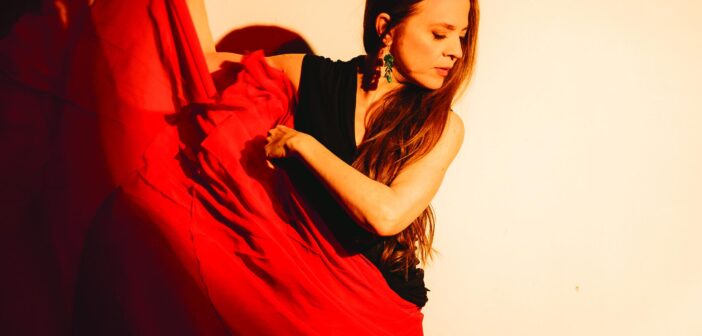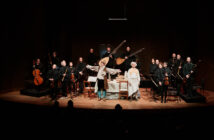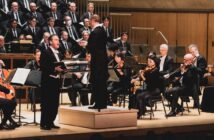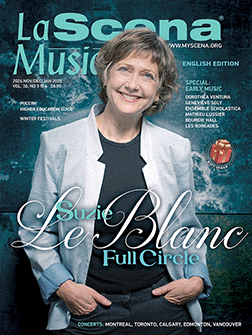
This page is also available in / Cette page est également disponible en:
Français (French)
Dorothéa Ventura knows how to do almost everything: dance, act, sing, conduct. The versatility of this artist is such that today she is employed as a harpsichordist, soprano, dancer and actress—and sometimes does double or triple duty!
Her preferred repertoire, however, remains Baroque music. Meet the woman who has taken over the reins of Les Idées heureuses, succeeding the ensemble’s founder, Geneviève Soly, as artistic director.
Snowy wedding, happy marriage
Dorothéa Ventura remembers the first concert of Year 1—38 years ago, in the middle of a snowstorm. “At the time, I was Geneviève Soly’s harpsichord student. She introduced me to Baroque music. I wanted to see it up close. The first thing I did—other than tear up the tickets and hand out the programs—was turn the pages for her, without much success. I gravitated around Idées heureuses as a volunteer for a long time. All the concerts were held at the former Erskine and American Church (now Bourgie Hall), where Geneviève was also organist,” she recounts.
It was with Les Idées heureuses that Ventura played her first professional concert as a harpsichordist. She went on to perform as a singer, dancer and, in some productions, actress. “This is truly an ensemble that has seen me grow up,” she says. “Geneviève’s handing over the reins to me two years ago was quite natural.”
Local songs
Les Idées heureuses are aptly named. The allusion to François Couperin’s eponymous piece for harpsichord obviously indicates a predominance of Baroque repertoire, but other periods and styles offer just as many opportunities for Ventura to cultivate the joy of making chamber music. This is particularly true of the concert scheduled for Nov. 12, entitled Jamais je ne t’oublierai. “I called on Jean-François Daignault, my musical accomplice for a very long time, and gave him carte blanche, which Geneviève had been in the habit of doing, but only with her assistant directors, of whom I was one for a year. Jean-François has a very personal vision. It was he who suggested that I make a link between medieval music, the Renaissance and French-Canadian folklore, because he saw similarities between themes, characters, sounds and songwriting techniques. We’ll be trying to weave a musical web to introduce the public to older pieces, and at the same time help them rediscover familiar ones, often associated with childhood. A lot of these songs are sung to you when you’re young, before you go to sleep, but for some reason you end up not hearing them anymore when you’re older. It’s going to be a concert about memories and childhood. I can’t wait to see what the mix of styles will bring.”
Music and dance in New France
Through the musical offerings of Les Idées heureuses, Ventura continues Geneviève Soly’s quest for Quebec identity as she researches the various religious communities in Quebec and the music associated with them. “About 15 years ago, we had already done a concert entitled Musique et danse en Nouvelle-France (Music and Dance in New France),” says Ventura. “I decided to bring it back, with new performers, a new script and staging by Marie-Nathalie Lacoursière that includes costumes, Baroque dance and comedy. We’ll all be multidisciplinary performers on stage. We’ll be dancing, singing and playing instruments. That’s something I love about being a multi-talented artist. We tell the story of a New France letter writer, Élisabeth Bégon, who paints a detailed, often humorous portrait of the colonial elite at the end of the French regime. The concert will feature readings from the letters, interspersed with music and short sketches. It will be a refreshing concert, and certainly unlike anything else.”
Drawing on the research of violinist Olivier Brault, Les Idées heureuses developed the show’s repertoire from scores found in the archives of the intendants of New France, which are known to have been brought back from the Old World. “It’s hard to tell what comes from here and what comes from Europe. My origins are European, but I was born here, so it’s important for me, from a personal point of view, to maintain this link,” says Ventura. “I couldn’t just do European music; you also have to be part of our local music.”
Versatility in demand
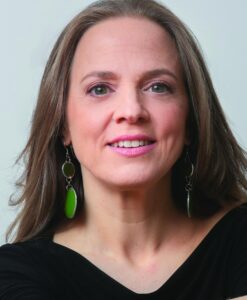
Crédit photo: Robert Etcheverry
Ventura’s professional activities extend far beyond the scope of Les Idées heureuses and Baroque music. Over the years, she has collaborated with ensembles from very different horizons,to the point where today she sees herself as a link—a common denominator that unites many artists around her. She is a regular member of the Opéra de Montréal chorus and the Orchestre symphonique de Montréal, as well as an active member of the Orchestre Métropolitain as organist, most recently in Bruckner’s Symphony No. 9 (September 2024). Her multiple talents in both instrumental and vocal parts sometimes leads her to combine several tasks to meet the needs of the ensembles that call upon her. “Once at the Opéra de Montréal, in Massenet’s Manon, I played the organ part backstage, even though I was initially hired as a chorister. Looking at the score, I realized that I could do both. So it happened that I played and sang at the same time.”
Today, the artist says she feels at home in all three areas of interpretation, including dance. This confidence has certainly come with experience in the profession, she says. “Now, versatility is something that is recognized and encouraged, but for a very long time, I had an imposter’s complex about doing so many things. When I was young, people in the business thought we were spreading ourselves too thin, that it wasn’t serious. They’d tell me, ‘One day, you’re going to choose.’ But I didn’t want to choose. I wanted to do several things as an artist. I had the impression that knowing how to sing helped me better understand how to play, and vice versa.”
Dorothéa Ventura’s initial intuition has been confirmed over the course of her career. “Knowing how to sing obviously enables me to better accompany a singer,” she says. “All the issues involved in singing, such as breathing and enunciation of the text, are elements I understand absolutely. Now that I also do Baroque dance, I know whether a minuet is too slow or too fast. I know, for example, that a sarabande that is too slow is impossible to dance. A gigue that isn’t fast enough is just as impossible, because you inevitably come down after jumping. Versatility, in my case and in Baroque art, is an asset.”
A passionate history
Ventura recounts how her parents met at the home of their piano teacher. Their practice remained amateur, but their interest in the instrument naturally led them to guide their two children along this path. “For my parents, it was important for my brother and me to play the piano. It was part of a normal education. I went to Collège Marie de France. Geneviève Soly, who was the music teacher there, asked at the end of the school year if any of her students wanted to play a piece. There was a piano in the classroom and I played a little Mozart sonata. The next day, she called my parents and told them I had to take up harpsichord. It was as easy as that. I tried out the harpsichord and it was a real discovery. Yes, I’d already played the piano, I liked it, but I’d always thought the instrument was a bit too big for me. When I came to the harpsichord, something clicked. The repertoire also spoke to me a lot more.”
A passion for dance came even before a passion for the harpsichord. For Ventura, it was a mode of expression she herself had chosen.“It all started with The Nutcracker. I saw this ballet at the age of 6 and said to myself that I wanted to be a dancer. I’ve never stopped since, and that’s what I started out to do. I graduated in classical dance from the École supérieure de danse du Québec. Later, I did a bachelor’s degree in contemporary dance at UQAM. In the meantime, fate spoke! When I was at dance school, the day before my audition for Les Grands Ballets Canadiens, I tore a ligament in my knee. It took me several months to get back on my feet, and I decided to reorient myself towards modern dance. I continued to play the harpsichord on the side, but there was nothing professional about it.”
At UQAM, Dorothéa Ventura met a dancer who was also a countertenor and studying voice at McGill University. He was looking for a harpsichordist to accompany him, and found her to be an ideal partner. He invited her to join him for a master class. The professor of the class heard her and asked her if she wanted to study harpsichord at McGill. “I ended up doing a bachelor’s degree at McGill at the same time as my bachelor’s at UQAM. That’s the beauty of youth! When you have that drive to learn and colleagues in the same boat, you discover that you’re not all alone behind a harpsichord or all alone at the bar. I could share the music with others, and that’s when I discovered the continuo. It was a very revealing moment for me, and I immediately had professional commitments. Later, I discovered that I could sing, too.”
Teacher and recruiter
Ironically, Dorothéa Ventura is now a vocal coach at McGill, teaching voice rather than harpsichord even though she holds a diploma in that instrument. Since the pandemic, she has even become a recruiter for Ensemble Caprice and Ensemble ArtChoral. “I hire a lot of singers for several productions,” she says. “I find myself on the lookout for talent. I love bringing projects and people together. It’s important for me to showcase what the musicians in an ensemble are capable of.”
Today, Ventura fully embraces her atypical career path. “Some people wonder what they’ll be doing in five years time, while others start thinking about career plans. But I’ve never done that. I’ve gone from strength to strength. The La Nef company, for example, offered me a crazy project, which I spontaneously accepted. My whole life has been built on chance encounters—on side roads. I never thought I’d be doing musical theatre one day, but I did take part in The Sound of Music for five years. Someone had heard me singing at a funeral and gave my name to Denise Filiatrault, who auditioned me. For all this to-ing and fro-ing, I’ve rather been rewarded.”
Jamais je ne t’oublierai, Nov. 12 at 7:30 p.m., in Bourgie Hall, Les Idées heureuses with Jean-François Daignault (flute, chalumeau, vocals, arrangements, musical direction).
Musique et danse en Nouvelle-France, Jan. 16, 2025, at 7:30 p.m, in Bourgie Hall of the Montreal Museum of Fine Arts. Performers : Catherine St-Arnaud (soprano, harpsichord, percussion, dance); Olivier Brault (violin, dance, vocals); Grégoire Jeay (traverso flute, percussion, dance, vocals); Mélisande Corriveau (viola da gamba, dance); Dorothéa Ventura (harpsichord, soprano, dance); Marie-Nathalie Lacoursière (dance, vocals, flute, staging). For the full program, visit www.ideesheureuses.ca
Translation: Heather Weinreb
This page is also available in / Cette page est également disponible en:
Français (French)

